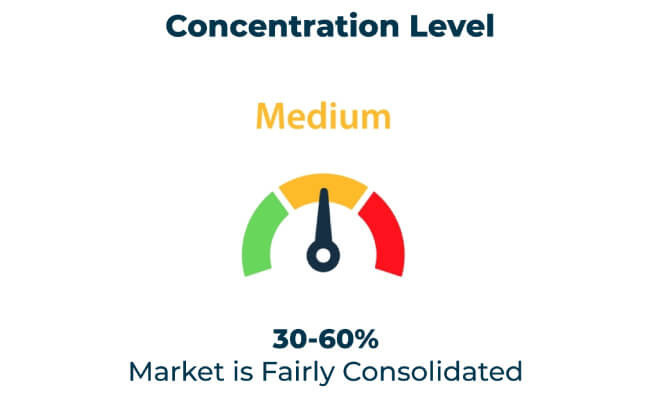The compostable packaging market is revolutionizing the global packaging industry at a fast pace, fueled by the ever-growing demand for sustainable solutions. Major players, such as TIPA, Amcor, and BASF, are leading this shift with innovative products and scalable solutions that cater to industries such as food and beverages, healthcare, and e-commerce.
Compostable packaging, designed to decompose into organic matter under composting conditions, aligns with global sustainability goals and offers a viable alternative to traditional plastics.
| Attributes | Details |
|---|---|
| Projected Size, 2035 | USD 8.1 billion |
| Value-based CAGR (2025 to 2035) | 9.3% |
TIPA specializes in flexible compostable packaging, where the solutions provided seamlessly integrate with existing supply chains while maintaining the performance of products. Amcor utilizes its know-how to generate high-quality compostable food and healthcare options with a high level of regulatory compliance. BASF has advanced biopolymer technology and develops compostable materials that are both functional and environmentally friendly.
It's majorly driven by three significant forces, corporations and governments increasingly embracing sustainability goals, consumers gaining consciousness about environment-friendly alternatives, and regulations that impose a complete ban on non-biodegradable plastics. Compostable packaging will reach USD 8.1 billion by 2035 with an estimated CAGR of 9.3%. These leaders, although fulfilling the demands of the existing market, shape the future by innovating strategies and partnering that would further their sustainable packaging lines.
Market Growth Drivers
Global Market Share & Industry Share (%), 2025E
| Category | Industry Share (%) |
|---|---|
| Top 3 (TIPA, Amcor, BASF) | 30% |
| Rest of Top 5 (Mondi, Novamont) | 10% |
| Next 5 of Top 10 Players | 5% |
Type of Player & Industry Share (%)
| Type of Player | Industry Share (%) |
|---|---|
| Top 10 | 45% |
| Next 20 | 10% |
| Remaining Players | 50% |

Year-over-Year Leaders
Businesses find significant potential in regions like Southeast Asia, Latin America, and Africa, where urbanization and waste management reforms fuel demand for compostable solutions. Lightweight and customizable compostable packaging caters to diverse market needs.
| Region | North America |
|---|---|
| Market Share (%) | 35% |
| Key Drivers | Strong regulatory support and consumer awareness |
| Region | Europe |
|---|---|
| Market Share (%) | 30% |
| Key Drivers | Leadership in sustainability initiatives and material innovations |
| Region | Asia-Pacific |
|---|---|
| Market Share (%) | 25% |
| Key Drivers | Growing adoption in food service and packaging industries |
| Region | Other Regions |
|---|---|
| Market Share (%) | 10% |
| Key Drivers | Rising demand in emerging markets |
The compostable packaging market is set to grow as businesses and policymakers address infrastructure gaps and invest in scalable solutions. Companies that prioritize innovation, affordability, and consumer education will lead the industry, paving the way for a sustainable packaging revolution.
| Tier | Key Companies |
|---|---|
| Tier 1 | TIPA, Amcor, BASF |
| Tier 2 | Mondi, Novamont |
| Tier 3 | Futamura, NatureWorks |
The compostable packaging market is at the forefront of sustainable packaging innovation, offering solutions that align with environmental goals and consumer preferences. Companies investing in material advancements, infrastructure collaboration, and consumer engagement will shape the future of this dynamic market. Addressing challenges such as cost and awareness will unlock immense growth potential and drive a global shift toward sustainability.
Key Definitions
Research Methodology
This report synthesizes data from primary interviews, secondary research, and market modeling validated by industry experts.
The global compostable packaging market is projected to witness a CAGR of 9.3% between 2025 and 2035
The global compostable packaging market is expected to reach USD 8.1 Billion by 2035
The share of top 10 players is 45% in the global compostable packaging market.
Mondi, Novamont, Amcor, BASF are few of the leading manufacturers of compostable packaging






Full Research Suite comprises of:
Market outlook & trends analysis
Interviews & case studies
Strategic recommendations
Vendor profiles & capabilities analysis
5-year forecasts
8 regions and 60+ country-level data splits
Market segment data splits
12 months of continuous data updates
DELIVERED AS:
PDF EXCEL ONLINE
Market Share Insights of Compostable Foodservice Packaging Providers
Compostable Adhesives Market Analysis - Size and Share Forecast Outlook 2025 to 2035
Compostable Tableware Market Size and Share Forecast Outlook 2025 to 2035
Compostable Straws Market Growth - Demand & Forecast 2025 to 2035
Compostable Food Trays Market Size and Share Forecast Outlook 2025 to 2035
Compostable Toothbrush Market Growth & Forecast 2025 to 2035
Global Compostable & Biodegradable Refuse Bags Market Insights – Trends, Demand & Growth 2025–2035
Compostable Mailer Market Growth & Trends Forecast 2024-2034
Compostable Pouch Market Insights – Growth & Forecast 2024-2034
Market Positioning & Share in the Compostable Food Trays Industry
Leading Providers & Market Share in the Compostable Toothbrush Industry
Market Share Distribution Among Compostable Refuse Bag Manufacturers
Compostable Packaging Equipment Market Size and Share Forecast Outlook 2025 to 2035
Compostable Packaging Films Market Size and Share Forecast Outlook 2025 to 2035
Compostable Plastic Packaging Material Market from 2025 to 2035
Compostable Foodservice Packaging Market Size and Share Forecast Outlook 2025 to 2035
UK Compostable Toothbrush Market Report – Key Trends & Growth Forecast 2025-2035
India Compostable Toothbrush Market Report – Key Trends & Growth Forecast 2025-2035
France Compostable Toothbrush Market Report – Key Trends & Growth Forecast 2025-2035
Hinged Lid Compostable Container Market

Thank you!
You will receive an email from our Business Development Manager. Please be sure to check your SPAM/JUNK folder too.
Chat With
MaRIA